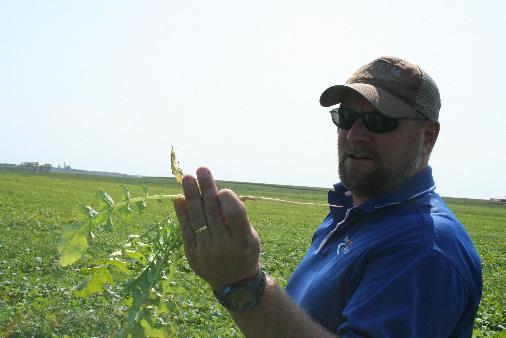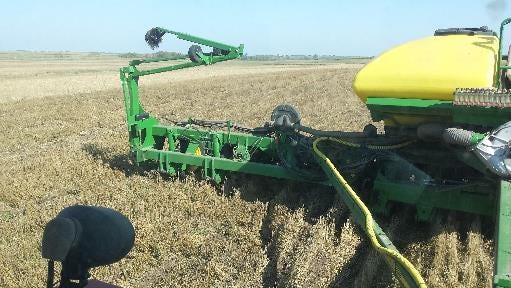April 30, 2018

Source: Natural Resources Conservation Service
By Janelle Atyeo, for the USDA NRCS South Dakota.
A month after planting a cover crop mix, Brian Johnson’s field was thick with leafy radishes and bright green spears of sorghum Sudan grass. In another month, the cows would be turned out for a few weeks of grazing this leafy mix.
It’s all part of a plan to prepare the field, which grew oats this season, for a healthy corn crop next year. Come spring, the cover crop will have decomposed, leaving a soft soil bed for seeding corn. Nutrients from the cover crop and the cows will be left behind as well, helping the corn to a strong start.
The busyness of corn and soybean harvest was still ahead of him, but Johnson was already looking forward to pulling his planter through that field just north of his Frankfort, South Dakota home. Cover crops make the soil conditions just right for planting.

A planter seeds a cover crop mix into wheat stubble at the Brian and Jamie Johnson farm south of Frankfort, S.D.
“It’s definitely mellow,” Johnson says. “It’s my ideal seed bed. It’s like butter.”
Johnson doesn’t till his fields. He aims his seed within the 2-inch row where the cover crops are growing now. That’s where they’ll land in the softest soil. When the corn or soybeans put down roots, they’ll follow the holes where radishes grew deep into the soil before turning to mush with winter’s freeze. Wheat straw residue next to the planting strip holds in moisture and shades the ground until the corn canopies.
Working the soil this way is known as bio stripping. The Johnsons have been seeing big benefits.
Brian farms with his wife Jamie and his parents Alan and Mickie Johnson. They’ve managed many of their fields without tilling for nearly 30 years, and they’ve been using cover crops in their rotation of corn, soybeans and wheat for nearly a decade.

NRCS District Conservationist Shane Jordan and producer Brian Johnson stand in a field of cover crops south of Frankfort, S.D. Cattle will graze the mix of millet, radish, turnip and sorghum Sudan grass, and oat bales are nearby for supplemental feed.
Now Jamie, who comes from a livestock background, is encouraging them to add to that diversity using their herd of registered black Angus cattle. She’d like to see the cows out grazing residue after harvest.
Already, they’ve created more pasture land by putting their least productive ground back into grass. It’s the opposite of the trend in 2009 and 2010 when many grassland acres in the area were plowed to plant crops because prices were so high.The area where the Johnsons farm south of Frankfort is known for its high-producing corn ground. Many farmers there plowed the grassland for crops in
“That’s stressful when you’re up against a blizzard,” Jamie said, recalling the harvest season three years ago when they worked past midnight to finish the work ahead of a November snowstorm.
Spreading out that harvest-time workload is another benefit of growing small grains and cover crops she likes best.
You May Also Like




